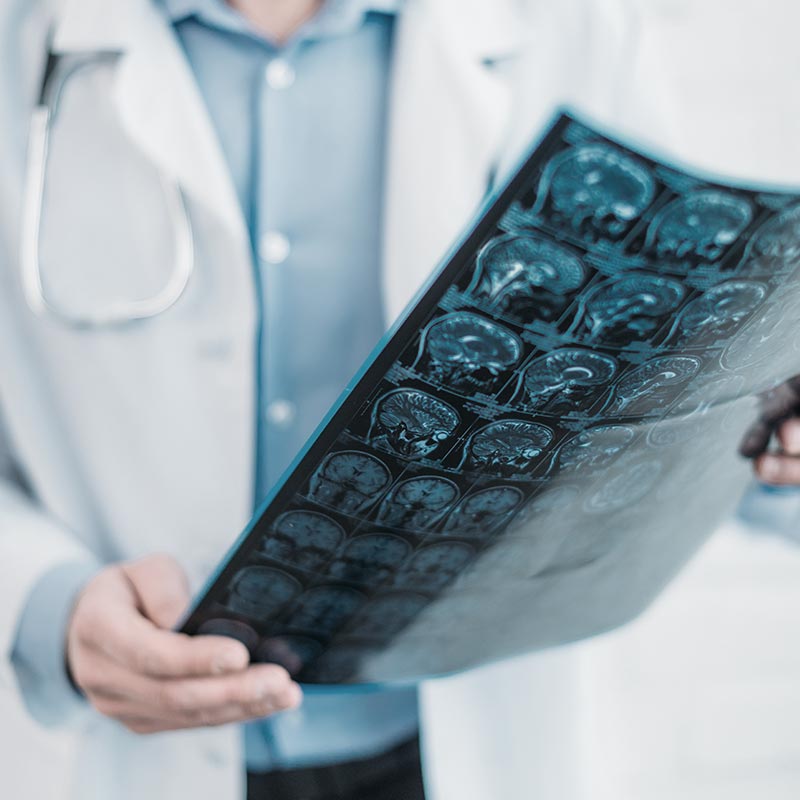TPS-Therapy - a Safe and Optimal Treatment Implementation by Prof. Musa Citak, M.D.
Transcranial Pulse Stimulation - Requirements
TPS Pulse Stimulation - The Preparation
In order to ensure a safe and optimal treatment implementation with transcranial pulse stimulation, we must first determine whether this therapy option is suitable for the patient.
About 65% of the affected dementia patients within our population suffer from Alzheimer’s dementia, which thus accounts for by far the largest proportion of dementia diseases. But even with Alzheimer’s dementia, there are often mixed forms, such as Alzheimer’s dementia combined with vascular dementia, body-Lewy dementia or frontotemporal dementia, as well as many other forms of dementia, which include about 50 different variants. In addition, many patients suffer from dementia as well as Parkinson’s disease or depression. And finally, it should be noted that, according to the current state of science, a definite or final diagnosis can only be made “post mortem”, i.e. after death.
Therefore, we can only decide individually whether the patient may be treated with Transcranial Pulse Stimulation after a detailed assessment of the neurological findings and in a personal conversation with the patient and his/her relatives as well as neurological tests. The personal expertise of Prof. Dr. med. Musa Citak as an experienced user and expert in regenerative medicine is therefore the first prerequisite for treatment with this Alzheimer’s dementia therapy.
Transcranial Pulse Stimulation - the necessary MRI
For treatment, we need an MRI, or magnetic resonance imaging. This is a procedure that uses magnetic fields and radio waves to produce cross-sectional images of the body, in this case the brain.
We need this MRI to be able to see our patients’ brains in real time during treatment. On the other hand, it serves the safety of our patients by allowing us to exclude certain contraindications in advance by means of an MRI.
The MRI should not be older than six months and should be performed by a radiologist without contrast medium.

In general, we recommend the following requirements for MRI images:
Para-sagittal MRI, T1-weighted, ~1mm in plane resolution and slice thickness (1x1x1mm).
MRI image: full head from forehead to back of head and ear to ear, ideally no aliasing artifacts (wrap-around).
The device supports a typical MR set (slices with 230×256 pixels and about 170-180 slices) or even higher resolution for diagnostic purposes.
A resolution of 1mm is sufficient.
We will be happy to send you these aforementioned requirements again by e-mail in advance if required.
Contraindications
Blood coagulation disorders
Coagulation disorders are a number of conditions in which the blood cannot clot properly, i.e. hemostasis (hemostasis) is disturbed. This is a vital physiological process of the body in which the blood is brought to a standstill after injuries to the blood vessels. If this process is disturbed, so-called hemostatic drugs are used. These are drugs that stop bleeding through various mechanisms. The range of types of coagulation disorders and medication is, of course, very extensive. It is therefore advisable to discuss the severity of the coagulation disorder and the appropriate medication in detail, if necessary.
Cortisone therapies
(Up to six weeks before treatment) Cortisone is a hormone that belongs to the group of so-called glucocorticoids. The hormone occurs naturally in our body and is produced in the adrenal cortex. Synthesized cortisone is used as a strong anti-inflammatory agent in various forms and dosages for a variety of diseases, such as asthma, joint inflammation and many chronic diseases. Since cortisone drugs interfere with the metabolism, it is advisable – if medically possible – to interrupt cortisone therapy six weeks before treatment. However, this can only be done in consultation with the treating physicians and with us.
Older pacemakers
Cardiac pacemakers have now been around for over 60 years. Over the course of time, they have been continuously developed. Today, they are efficient and powerful high-tech devices with a long service life. Since pacemakers work with electrical pulses, it must be ensured that these pulses do not interfere with the pulses of the shock waves and vice versa. In the meantime, all pacemakers generally meet these requirements, otherwise the respective patients would not be able to undergo an MRI, which is a prerequisite for the treatment. If a patient has been wearing a pacemaker for many years, the safety of the pacemaker type should be verified in advance.
Brain tumors
Brain tumors are initially a general term for all benign or malignant tumors originating from brain tissue. In a broader sense, all tumors that grow within the cranial cavity or develop as metastases of extracranial tumors are referred to as brain tumors. A tumorous occurrence within the treatment area, i.e. in our case in the head area, is therefore also a contraindication for safety reasons.
Thromboses
Thromboses are blood clots in blood vessels, the heart or also in the brain. The latter are so-called sinus thromboses in blood vessels that transport blood from the brain towards the heart. Since transcranial pulse stimulation is supposed to promote angiogenesis (formation of new blood vessels) according to studies, thromboses are a contraindication for safety reasons.
Metal objects in the head region
Brain pacemakers or metal implants that have been inserted, e.g. after an accident as a cranial bone replacement, are basically contraindicated for transcranial pulse stimulation.
Summary: If Transcranial Pulse Stimulation is medically indicated in a patient, an MRI prepared according to the aforementioned criteria is available, and all of the aforementioned contraindications have been ruled out or examined and verified in individual cases, treatment can be started immediately.

